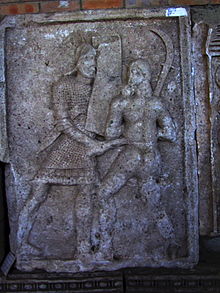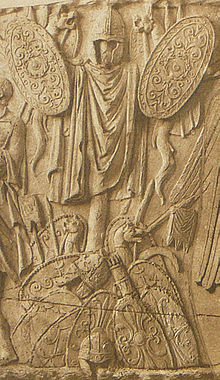Dacian warfare

The history of Dacian warfare spans from c. 10th century BC up to the 2nd century AD in the region defined by Ancient Greek and Latin historians as Dacia, populated by a collection of Thracian, Ionian, and Dorian tribes.[1] It concerns the armed conflicts of the Dacian tribes and their kingdoms in the Balkans. Apart from conflicts between Dacians and neighboring nations and tribes, numerous wars were recorded among Dacians too.
Mythological
This section needs expansion. You can help by adding to it. (September 2009) |
Tribal wars
The Dacians fought amongst each other[2] but were later united under Burebista. However, after his death[3] in 44 BC, the empire again descended into conflict culminating in a full-scale civil war. This led to the division of Burebista's empire into five separate kingdoms, severely weakening the Dacian's defensive capabilities against enemies, particularly Rome.[4] The Dacian tribes were again consolidated under Decebalus, who achieved several military victories in a series of battles with the forces of Emperor Domitian.
This section needs expansion. You can help by adding to it. (September 2009) |

The history of Dacian warfare spans from c. 10th century BC up to the 2nd century AD in the region defined by Ancient Greek and Latin historians as Dacia, populated by a collection of Thracian, Ionian, and Dorian tribes.[1] It concerns the armed conflicts of the Dacian tribes and their kingdoms in the Balkans. Apart from conflicts between Dacians and neighboring nations and tribes, numerous wars were recorded among Dacians too.
Domitian's Dacian War
The two punitive expeditions mounted as a border defense against raids of Moesia from Dacia in 86-87 AD ordered by the Emperor Titus Flavius Domitianus (Domitian) in 87 AD, and 88 AD. The first expedition was an unmitigated disaster, and the second achieved a peace, seen as unfavorable and shameful by many in Rome.
Trajan's Dacian Wars
Trajan's Dacian Wars. The two campaigns of
Dacian troop types and organization
This section needs expansion. You can help by adding to it. (September 2009) |
The Dacians, like any other barbarian nation, never fielded a standing army, even though there was a warrior class of sorts, the
Infantry and cavalry
The

After the sound of the carnyx war trumpet, the Dacians went to battle with the
Using the falx, the Dacian warriors were able to counter the power of the compact, massed Roman formations. During the time of the


The Dacians were adept[citation needed] at surprise attacks and skillful, tactical withdrawals using the fortification system. During the wars with the Romans fought by their last king Decebalus (87-106), the Dacians almost crushed the Roman garrisons south of the Danube in a surprise[citation needed] attack launched over the frozen river ( winter of 101-102 ). Only the intervention of Emperor Trajan with the main army saved the Romans from a major defeat. But, by 106, the Dacians were surrounded in their capital Sarmizegetusa. The city was taken after the Romans discovered and destroyed[citation needed] the capital's water supply line.
Dacians decorated their bodies with tattoos like the Illyrians[10] and the Thracians.[11] The Pannonians north of the Drava had accepted Roman rule out of fear of the Dacians.[12]
Dacia remained a Roman province until 271.
Have poured her captains, and the troops who guard the northern frontier from the Dacian hordes
Dacians that could afford armor wore customised
Most[citation needed] of the infantry would wield a falx and perhaps a sica and would wear no armor at all, even shunning shields.
This section needs expansion. You can help by adding to it. (September 2009) |
Mercenaries
Dacian mercenaries were uncommon in contrast to the Thracians and the Illyrians but they could be found in the service of the Greek Diadochi[15] and of the Romans.[16]
Nobility
A 2nd century chieftain would wear a bronze
This section needs expansion. You can help by adding to it. (September 2009) |
The ancient historian Ptolemy mentions a naval battle between the Geto-Dacians and the Romans near the island of Eukon (most likely today's Popina Island).
Fortifications

Dacians had built fortresses all around Dacia with most of them being on the
The Dacians constructed stone strongholds,
External influences
Thracian
This section is empty. You can help by adding to it. (February 2011) |
Scythian and Sarmatian
This section needs expansion. You can help by adding to it. (September 2009) |

The Dacian Draco was the standard of the ancient Dacian military. It served as a standard for the Dacians of the La Tène period and its origin must clearly be sought in the art of Asia Minor sometime during the second millennium BC.[20]
Sarmatians were part[21] of the Dacian army as allies.The Roxolani became part of the Dacians while the Iazyges fought against them trying to claim their own land.[22]
The Celts played a very active role in Dacia as enemies that were easily defeated by Dacians.[23] The Scordisci were among the defeated Celts that the Dacians conquered.[24]
Greek/Hellenic
This section needs expansion. You can help by adding to it. (September 2009) |
Roman


After their defeat, the Dacians were ethnically cleansed. Young men were either killed or became slaves or legionaries. The remaining population was expelled and their lands were given to colonists.[8] Later, the Romans started minting a coin called Dacicus[26] was minted by Domitian.
This section needs expansion. You can help by adding to it. (September 2009) |
Barbarians
The
.This section needs expansion. You can help by adding to it. (September 2009) |
List of Dacian battles
This is a list of battles or conflicts that Dacians had a leading or crucial role in, rarely as mercenaries. They were involved in massive battles against Roman legions.
- Unknown date. Celtic Boii in Bohemia against Dacian tribes from the lower Danube,[31] Dacian victory
- 1st century BC Dacians against Scordisci,[citation needed] Dacian victory
- 86
- 87, First Battle of Tapae,[citation needed] Dacian victory
- 88
- 101, Second Battle of Tapae,[citation needed] Roman victory
- 102, Battle of Adamclisi,[citation needed] Roman victory
- 103, Battle of Gatae,[citation needed] Roman victory
- 105
- 106, Battle of Sarmisegetusa,[citation needed] Roman victory
See also
- List of ancient cities in Thrace and Dacia
- List of ancient tribes in Thrace and Dacia
- List of rulers of Thrace and Dacia
- Thracian warfare
- Illyrian warfare
- Celtic warfare
- Falx
- Sica
References
- ^ ISBN 1563246767.
- ISBN 9789386019806.
- ^ The Legionary by Peter Connolly, 1998, page 14: "... dynamic king Burebista, a century and a half earlier, the Dacians had become the most powerful nation in central Europe, but since his death the country had been split by civil war."
- ISBN 9780761844655.
- ^ A Companion to the Roman Army (Blackwell Companions to the Ancient World) by Paul Erdkamp, 2007, page 218
- ^ ISBN 0-415-165245.
- ISBN 0-415-165245.
- ^ ISBN 0-415-165245.
- ^ Rome's Enemies (1): Germanics and Dacians (Men at Arms Series, 129) by Peter Wilcox and Gerry Embleton, 1982, page 35
- ^ The Illyrians by John Wilkes, 1996, page 198: "...their armor is Celtic but they are tattooed like the rest of the Illyrians and Thracians..."
- ^ The World of Tattoo: An Illustrated History by Maarten Hesselt van Dinter, 2007, page 25: "... in ancient times. The Danube area Dacians, Thracians and Illyrians all decorated themselves with status-enhancing tattoos, ..."
- ^ The Oxford Classical Dictionary by Simon Hornblower and Antony Spawforth, 2003, page 1106, "Pannonia north of the Drava appears to have accepted Roman rule without a struggle probably owing to fear of the Dacians to the east.
- ^ Luc. 8.331
- ISBN 0850454735, 1982
- ISBN 387940707X, 2000, page 83
- ISBN 387940707X, 2000, page 115
- ^ Rome's Enemies (1): Germanics and Dacians (Men at Arms Series, 129) by Peter Wilcox and Gerry Embleton, 1982
- ^ Dacia: Land of Transylvania, Cornerstone of Ancient Eastern Europe by Ion Grumeza, 2009, page 13, "The shores of the Danube were well monitored from the Dacian fortresses Acidava, Buricodava, Dausadava (the shrine of the wolves), Diacum, Drobeta (Turnu Severin), Nentivava (Oltenita), Suvidava (Corabia), Tsirista, Tierna/Dierna (Orsova) and what is today Zimnicea. Downstream were also other fortresses: Axiopolis (Cernadova), Barbosi, Buteridava, Capidava (Topalu), Carsium (Harsova), Durostorum (Silistra), Sacidava/Sagadava (Dunareni) along with still others..."
- ^ The Cambridge History of Greek and Roman Warfare: Volume 2, Rome from the Late Republic to the Late Empire by Philip Sabin, Hans van Wees, and Michael Whitby, 2007, page 149: "... 4.5 Scene from Trajan's column depicting Roman troops attacking a Dacian fortification, using the famous testudo (tortoise) formation to shield themselves from ..."
- ^ Parvan Vasile (1928) in 'Dacia', Bucuresti, page 125
- ^ Dacia: Land of Transylvania, Cornerstone of Ancient Eastern Europe by Ion Grumeza, 2009, page 170
- ^ Dacia: Land of Transylvania, Cornerstone of Ancient Eastern Europe by Ion Grumeza, 2009, page 134
- ^ Dacia: Land of Transylvania, Cornerstone of Ancient Eastern Europe by Ion Grumeza, 2009, page 88
- ^ Strab. 7.5, "...they often used the Scordisci as allies..."
- ISBN 978-1-84176-329-3, 2001, page 14, "It shows a Hellenised king of the Getae..."
- ^ Dacicus, "Dācicus, a gold coin of Domitian, conqueror of the Dacians..."
- ^ The Barbarians Speak: How the Conquered Peoples Shaped Roman Europe by Peter S. Wells, 2001, page 105, "... so too the Emperor Trajan represented the Dacians as a strong threat to Roman authority on the lower Danube. These barbarian enemies are represented in heroic fashion, as dignified warriors ..."
- ^ Q. Horatius Flaccus (Horace), Odes, John Conington, Ed.Hor. Carm. 1.35, "The fierce Dacians, and Scythian hordes, people and towns, and Rome, their head, and mothers of barbarian lords, and tyrants in their purple dread,..."
- ^ Tac. Hist. 3.46, "The Dacians also were in motion, a people which never can be trusted..."
- ^ Dacia: Land of Transylvania, Cornerstone of Ancient Eastern Europe by Ion Grumeza, 2009, page 54, "The Greeks were so impressed with his achievements that they named him 'the first and greatest king of the kings of Thracia'...."
- ^ Celtic Warrior: 300 BC-AD 100 by Stephen Allen and Wayne Reynolds, 2001, Front Matter,"... 60: Celtic Boii in Bohemia defeated by Dacian tribes from the lower Danube. 58-51: Caesar's campaigns in Gaul ..."
